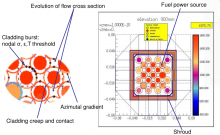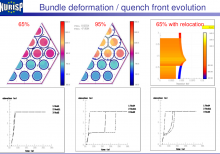DRACCAR
DRACCAR is a new 3D-thermal mechanical computer code to simulate LOCA (loss of coolant accident) transient on Nuclear Power Plants developed at IRSN (Institute for Radiological Protection and Nuclear Safety).
It can simulate the behavior of different types of fuel, such as UO2 and MOX, with different cladding materials, such as Zr-4 and M5, in an experimental environment – a setup generally limited to a few rods surrounded by a shroud – as well as that of an actual 17x17 assembly, as in the case of a French PWR (Pressurized Water Reactor).
The code is also able to study the deformation and re-flooding of a fuel rod assembly in three-dimensional geometry during a loss of coolant accident (from which the acronym is derived in French).
The tool is being developed from components of the ICARE calculation software, which models in axisymmetric geometry most of the physical phenomena coming into play during a LOCA: swelling of the cladding (creep), rupture, depressurization of the cladding after rupture, the release of fission gases, heat exchanges, oxidation of the zirconium by water vapor, and, lastly, oxidation of the inside surface of the cladding. These items are supplemented in DRACCAR with the modeling of some phenomena not addressed by ICARE, such as:
- hydriding and diffusion of oxygen in the metal layer of the cladding having an effect on mechanical properties
- relocation of fuel fragments in the deformed areas of the cladding (balloons) modifying the axial distribution of the heat sources
- mechanical interaction of a deformed rod with neighboring structures (fuel rod, control rod, grid, or shroud)
- bowing of the rods (propagation of the axial deformations, which tends to bring the hot fiber of the cladding closer to the fuel,thus accentuating the hot point effect)
Heat transfer:
- thermal conduction in the whole structures,
- convective exchanges between the fluid and the structures,
- radiative exchanges between structures,
- heat exchange (conduction + radiation) through a gap,
- 3D temperature distribution.
Material properties:
- intrinsic laws from the IRSN Material Data Bank for Power Plant applications,
- creep laws, anisotropy coefficients, integrity criteria, ...,
- description of the material behavior under imposed constraints: temperature, pressure, burn-up, oxidation, hydriding, ...,
Additional phenomena:
- fragmented fuel relocation in the balloons:
- parametrical model (HALDEN): filling ratio, starting time, filling velocity
- Structures oxidation by the vapor.




